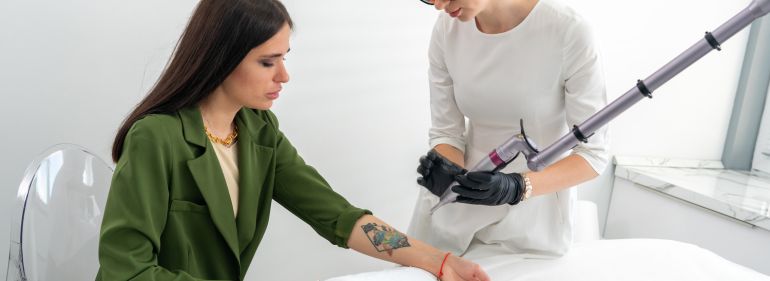- Prity Skincare Clinic
- Laser Tattoo Make-up Removal
Laser Tattoo Make-up Removal

Laser Tattoo Make-Up Removal
Lasers remove tattoos by breaking up the pigment colors with a high-intensity light beam. Black tattoo pigment absorbs all laser wavelengths, making it the easiest color to treat. Other colors can only be treated by selected lasers based upon the pigment color.
You should first schedule a consultation with our trained professional who can evaluate your tattoo and advise you on the process. The number of treatments you will need will depend on the age, size, and color(s) of your tattoo. The color of skin, as well as how deep the tattoo pigment goes, will also affect the removal technique.
Laser Tattoo Removal

Laser Tattoo Make-up Removal
Laser Tattoo Removal
Lasers remove tattoos by breaking up the pigment colors with a high-intensity light beam. Black tattoo pigment absorbs all laser wavelengths, making it the easiest color to treat. Other colors can only be treated by selected lasers based upon the pigment color.
Price: £100
(Price For Per Treatment)
Lasers remove tattoos by breaking up the pigment colors with a high-intensity light beam. Black tattoo pigment absorbs all laser wavelengths, making it the easiest color to treat. Other colors can only be treated by selected lasers based upon the pigment color.
You should first schedule a consultation with our trained professional who can evaluate your tattoo and advise you on the process. The number of treatments you will need will depend on the age, size, and color(s) of your tattoo. The color of skin, as well as how deep the tattoo pigment goes, will also affect the removal technique.
The duration of the tattoo removal process is depends on the size of tattoo.
Some patients may wish to remove a visible tattoo before an event – such as their wedding or enlisting in the military. It’s important to establish upfront that tattoo removal is a process that relies on the body’s ability to eliminate ink from the skin.
It’s not unusual for the body to take over a year to completely eliminate ink. Setting expectations clearly upfront allows patients to be satisfied throughout the experience – rather than feeling as if they were misled.
To allow the skin enough time to heal between treatments and the body’s immune system to flush away ink, we recommend a minimum of six weeks between laser session and eight weeks for darker complexions. Stacking the treatments too close together can cause damage and permanent side effects to the skin and doesn’t allow the body enough time to remove the ink that was shattered at the most recent session. For ideal results, we recommend waiting three months between treatments.
Ultimately, as a tattoo removal practitioner, i don’t know precisely how many treatments a tattoo will need to be fully removed. However, you should assess the patient’s tattoo for how easily it should remove. Tattoo removal treatments fit along a bell curve – most patients will need between fine and eight treatments, some will see complete removal in three or four, and others may need 10 or more treatments if there is significant scarring or layered tattoos. We suggest telling patients where they are likely to fit along the bell curve based on the unique factors of their tattoo.
Laser tattoo removal typically does involve some level of pain. That said, many say that it hurts less than they expected. Pain tolerance and threshold varies from person to person.
It’s a common belief that tattoo removal is excruciating, yet most patients say that the sensation of removal is comparable to having a tattoo applied. Common descriptions include the sensation of a rubber band snapping against the skin or bacon grease – basically it’s uncomfortable but bearable.
It hurts, but it’s bearable.
When discussing pain with patients, it’s important to share that while they may experience some level of discomfort, the pain is relatively manageable and tolerable. It may take some tough love to encourage patients concerned about sensitivity.
The vast majority of tattoo removal providers offer some form of soothing to the skin during the treatment. Offering skin numbing during the procedure allows your practice to stay competitive, provide better patient care, and have higher patient satisfaction.
What many people don’t know is that any scarring that remains after a tattoo removal procedure is often left over from when the tattoo artist originally applied the tattoo.
Another risk for scarring, even if the treatment is performed properly, happens when patients fail to follow aftercare instructions. Blisters and scabs are common side effects that are important in the tattoo removal healing process. However, picking scabs or not caring properly for blisters can allow scarring to happen. When discussing aftercare with your patients, make sure to emphasize their role in the outcome of their tattoo removal.
When a laser treats the skin, it targets and breaks down the tattoo pigment in the skin. If pre existing scarring is present, it will break down this pigment within the scar tissue. Once the tattoo removal process is complete, the ink will have been eliminated from the location but any of the scarring from the original tattoo will likely still remain.
Side effects are to be an expected part of the tattoo removal process for most patients. In fact, some side effects are an important part of the immune response that helps eliminate ink from the skin.
All patients should expect some level of side effects.
The most common side effects are:
- Redness
- Tenderness
- Swelling
- Blistering
- Scabs
- Bruising
- Hyperpigmentation
- Hypopigmentation
If all of the proper protocols are used based on the tattoo and the patient’s skin tone, all of these side effects are temporary. Redness, tenderness, and swelling typically subside within two weeks following treatment. Blisters usually appear within 24 hours of treatment; sometimes the blisters are very large and may look alarming – this is completely normal. Scabs, bruising, and blistering may take up to a week or longer to heal.
Hyperpigmentation and hypopigmentation occur when the body’s production of melanin is skewed after a laser treatment. With hyperpigmentation, the body overproduces melanin in reaction to the laser treatment, so skin in the treated area is darker than the natural skin tone. With hypopigmentation, the melanin is depleted by the laser treatment and the skin appears bleached. Both hypopigmentation and hyperpigmentation are typically temporary and resolve naturally with time. Patients with middle to darker skin tones are at the greatest risk for pigmentation changes and should avoid sun exposure the weeks following each treatment.
With the appropriate laser and trained professional, the procedure is not only safe, but has the best track record for unharmed or damaged skin. Each patient’s treatment plan is thoroughly assessed, their progress is recorded and managed, and aftercare plans are always followed up with by our laser technician.
The procedure is a painful one as the ink is being shattered in the secondary layer of skin (the dermis). However, with the application of a strong numbing cream, the procedure is more than tolerable since the pain does not linger after the treatment is completed. With the proper application, it can be comparable to getting a tattoo. Unlike a tattoo with a consistent lingering pain, the pain from laser tattoo removal is temporary, leaving only a warm feeling on your skin.
No, once the ink has been shattered, it will remain shattered. Each session will break up more ink particles into smaller granules which will make it easier for your immune system to remove. It can, however, take some time for your immune system to carry the shattered ink particles away.
- Do not exercise for 4 to 7days post a treatment. The area will feel slightly tender post a treatment, so the last thing you want to do is aggravate or hurt the area.
- Avoid excessive heat to the skin. Whilst it is ok to shower 2 hours after a treatment, please avoid high-pressure hot showers, or soaking in a bath or sauna for at least 1 to 2 weeks afterwards.
- Make sure to keep the area clean and dry during the healing process. A mild soap can be used and make sure to pat dry and do not rub.
- Do not expose the treated area to the sun. If you must be in the sun for work or any other reason, please make sure to use a good sunscreen. We recommend Beachfox. For extra protection from the sun, use sunscreen and keep the area covered up with clothing.
- It is quite common to get blisters after a treatment. No cause for concern here as, it is all part of the healing process. Blisters are a sign that your immune system is healing the area and
- removal of ink has started. Let the body break the blister down naturally (as we don’t want to cause scarring or infection) and apply Stratamed (available in the clinic) or an antibiotic ointment after the blister has popped and keep the area covered up for added protection.
- For pain relief, you can take Paracetamol and it is best to avoid Aspirin as it can increase the risk of bruising or bleeding.
- Do not pick or scratch at the treated area. This is important as we do not want to scar the area or cause infection.
- Try to avoid shaving until the area has completely healed.
- If the treated area has that slight sunburn feeling, a cool compress can be used to ease discomfort.
- A few weeks after a treatment, as the area continues to heal, it may get itchy. This is all part of the healing process. To ease the itchiness, you can apply 1% hydrocortisone cream or a Vitamin E ointment.
- Complete healing takes 6 to 8 weeks. It may seem like the surface of the skin has healed in a few weeks. The deeper layers, the Dermis, is still healing. This is why we wait at least 6 weeks before the next treatment.
- Your immune system plays a huge part in the healing as well as the ink elimination process. Give your immune system a boost by getting rest, drinking plenty of water and eating healthy.
It takes about 2 weeks for the treated skin area to heal. After your laser removal treatment session, keep the skin area covered with gauze and plain petroleum jelly (Vaseline). The petroleum jelly helps to seal and protect the skin and allowing it to heal. After this period the skin has typically healed and you can carry on as usual. One important part of the tattoo removal healing process to remember is to avoid direct sun or unwanted darkening of the skin. Using high UV protection is recommended during summer months.
Occasionally the treated skin area can experience collateral damage due to the exploding ink particles. Skin blisters are usually uncommon and don’t cause permanent damage. If the blisters are large, they can be drained using sterile needles at the clinic. We highly recommend you avoid popping blisters yourself.. It’s unnecessary and they will drain on their own during the first week after treatment. Blistering can manifest on some patients whose tattoos are very new, have very dense in ink (cover ups), or people with who are prone to blistering from sunburns.
Laser tattoo removal and laser hair removal are treatments that both follow a similar practice, so if you have had laser hair removal before, you will know what to expect from laser tattoo removal. Both treatments use hand held laser devices to target pigment in the skin, with tattoo removal targeting ink pigment rather than hair pigment.
The wavelengths, either red light or infrared, in the laser disrupt the natural state of the pigment, causing the ink particles to shatter and dissolve. The tattoo removal works to remove any ink present and each treatment helps to fade and lighten the tattooed areas.
You need to wait 6-8 weeks between each session for the skin to heal in order to continue removing your eyebrow tattoo with a laser.
Microblading Correction: The Laser Eyebrow Tattoo Removal Process. If you’ve had microblading and are not satisfied with the results, the good news is that it can be corrected. Often called a microblade correction, it is a safe procedure that is similar to other laser tattoo removal treatments.
It takes between 1-12 treatments to remove the permanent makeup. In three cases, the color of the permanent makeup could not be removed by laser and remained after the treatment. In two cases, laser treatment had to be terminated due to color changes towards the green-blue spectrum.
When the laser treatment breaks down the ink and releases these metal components, they oxidize, or undergo a reaction in which they chemically combine with oxygen. This turns the white pigmentation into a darker, gray shade, spreading a darker color over the tattoo.
There may be some lightening or darkening of the skin for several months after laser treatment. Protect the treated area from sun exposure until the skin is completely healed and the skin color has returned to normal. Your tattoo usually fades over 4-6 weeks.
There’s no indications that laser tattoo removal with a Picosure laser will cause permanent hair loss. However, some hair loss at the treatment site can occur, but will typically grow back within the normal healing time.
The potential chances for hair loss depends on several factors. The type of ink used in the tattoo, the location and the size and scope of the tattoo design. Laser tattoo removal happens very quickly that chances of damaging hair follicles is minimal.


